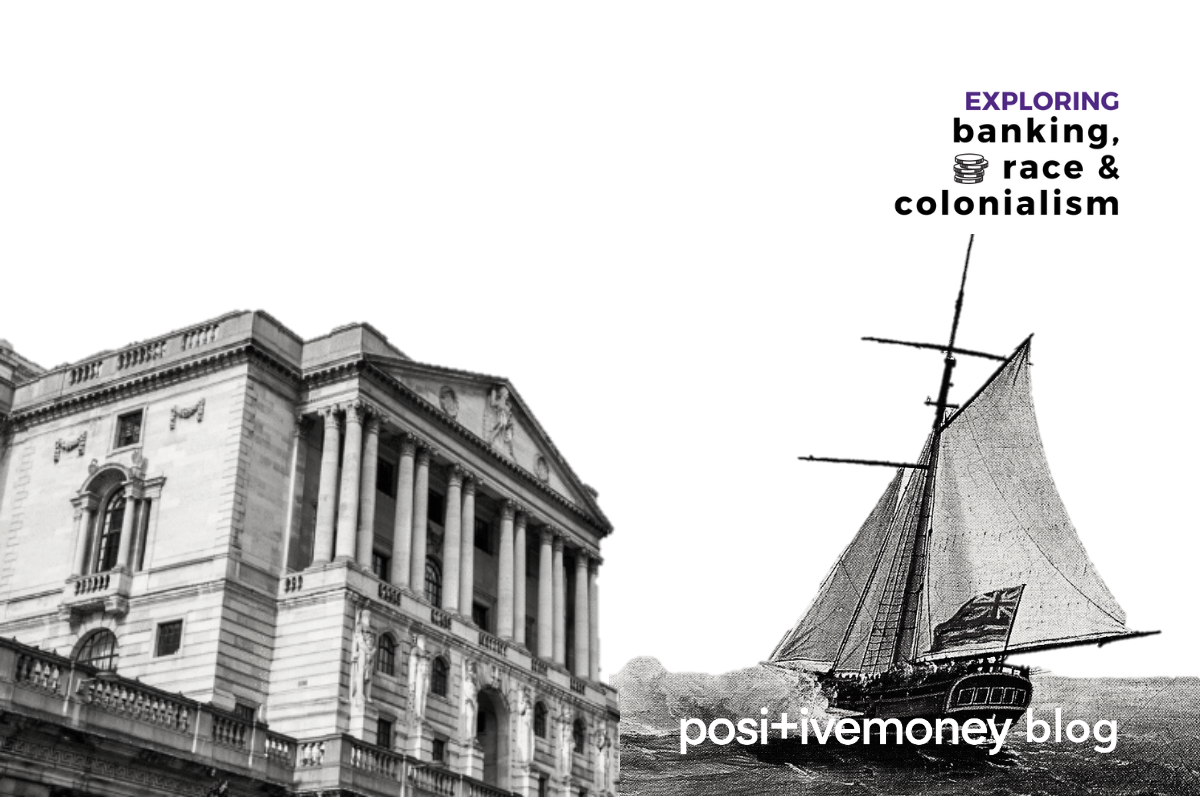
Finance and DemocracyUK
18 December 2025
Positive Money staff team recently took a guided tour of The Bank of England Museum “Slavery & the Bank” exhibition, which explored how the Bank, its Governors and Directors, the City of London, and Britain as a whole was linked to, and benefited from, the slave trade. Despite recognising its historical responsibility for racial inequality, the Bank of England continues to resist creating a racially just future.
It has been two years since the global Black Lives Matter Protests, which challenged white-led institutions for perpetuating structural racism. In the wake of this movement, the Bank of England apologised for its “indirect links” to the slave trade, and limited its action to the removal of art of former slave owners. Since then, the Bank has commissioned research into its links with slavery, which was presented in its (recently closed) “Slavery & the Bank exhibition”. The exhibition’s research confirmed what many Black historians have been arguing for a long time: the wealth of modern day Britian was built on the backs of slaves and British colonies. Within the UK, racial wealth inequalities which emerged out of slavery and colonialism persist today, with the median total wealth of a Black African headed household just £34,000 compared to £314,000 for a White British household. In addition, recent data highlighted that Black households will disportionately suffer from the cost of living crisis, with 4 in 5 having less than £1,500 in savings.
Whilst the Bank has finally recognised its role in fuelling slavery and colonialism, it continues to fall short of implementing any truly transformative policies that would alleviate the unjust and unequal economic conditions faced by racialised communities. Seemingly keen to keep an arms length from its own past, the exhibition crucially lacked any presence or endorsement from the Bank’s senior leadership. During the Q&A at the end of the tour, visitors poignantly asked: what are the implications for people of colour today, both in the UK and in formerly enslaved and colonised nations? Although the curators were clear that the exhibition provided historical evidence that supports the case for racial justice, the Bank’s policymakers do not appear to be listening. So far, the Bank of England has failed to make any significant policy changes to help redress the inequalities that resulted from its actions.
44 former staff of the Bank of England were associated with the slave trade, by being slave owners, estate owners, or acting as attorney, mortgagee, or legatee for estates. The Bank directly benefited from these financial associations, as wealthy individuals who sought to become a Governor or Director of the Bank were required to invest in the Bank as a private shareholder. Therefore, funds gained by Bank staff as a result of owning slave estates could have been subsequently issued as Bank loans.
The Bank itself made a direct income from two sugar plantations it owned for over a decade in Grenada, before selling them in 1790 for £100,000 (the equivalent of £15 million today). The names of the 599 people enslaved on these plantations were somberly listed at the centre of the exhibition. During our tour, descendants of Grenada that were present described how they were saddened by the likeness of the list of names to their own families and friends.
The Bank of England played a crucial role in financing the UK Government to become the dominant slave trading nation and colonial empire. Through developing long term credit instruments, the Bank financed slave planatations and slave voyages as part of the translatlatic slave trade, as well as private armies and weapons used to secure colonies. Most disturbingly, credit advanced to slave traders and planation owners was secured on the basis of their main asset — African bodies. As explained by the exhibition, the entire City of London, supported by the Bank of England, was fundamental to the slave trade, with banks such as Baring’s and Rothschild’s providing funding for America’s cotton plantations. Companies engaged in slave trading, including the East India Company, Royal African Company and South Sea Company, were supported in their imperial missions overseas by the Bank of England’s provision of bank accounts and overdraft facilities.
Formerly enslaved and colonised nations and people have tirelessly argued that beyond token gestures, those that extracted wealth, resources, and free labour for centuries should deliver a program of reparations. This could include the Bank compensating the descendants of the 599 people enslaved at the two plantations it once owned. The unjust truth is that the Bank has instead been involved in compensating slave owners for the loss of their ‘human property’ under the 1837 Slave Compensation Act, repayments of which were only concluded in 2015.
Beyond individualised responses, we need to see a coordinated approach by governments and central banks of the Global North towards reparations on a global scale. As argued by Olúfémi Táíwò, “the banks financing all of this were thousands of miles away from the shareholders profiting off the colony, which was thousands of miles away from the actual colony”. Therefore, reparations should be scaled and directed towards reforming an economic system that continues to extract wealth, and is structured by racial hierarchies. As the supervisor of the City of London, the Bank of England should act rapidly to mitigate climate change, the impact of which will disproportionately harm communities in the Global South. Global inequality and poverty must be addressed by ending predatory loans of private creditors to racialised communities and countries in the Global South. This should include debt forgiveness to the most heavily indebted countries, some of which are cutting as much as 3% of their public spending due to debt repayments.
Present day racial inequalities in the UK continue to be perpetuated through powerful institutions such as the Bank of England. The Bank must meaningfully consider how its policies, such as quantitative easing, have increased wealth inequality. Better coordination between the Bank and the Treasury is needed to ensure financial wealth is created and directed towards the needs of Black, people of colour and marginalised communities. The UK could replicate the US Community Reinvestment Act that requires regulators to ensure that financial institutions expand credit access to low and middle income communities. In its decision-making structures, the Bank should diversify its policy committees to include Black and people of colour from civil society backgrounds. The Bank of England should also promote a more diverse financial system, with more stakeholder run banks such as credit unions. Black and ethnic minority communities in the UK, such as those from the Windrush generation, have developed their own financial insitutions in response to their experiences facing racial discrimination when trying to access mainstream banks. Finally, the Bank should gather data on ethnicity and discimination in accessing finance today, to help guide financial support towards the needs of communities that are currently underserved and excluded.
Ultimately, the forms of reconciliation that should take place must be decided through dialogue with those most affected, and should be undertaken with their consent. The Bank of England should, therefore, use this exhibition as impetus to redress its liability for racial inequality and take responsibility for righting these wrongs.
To learn more about the issues raised in this post, please read our Exploring Banking, Race and Colonialism blog series.
